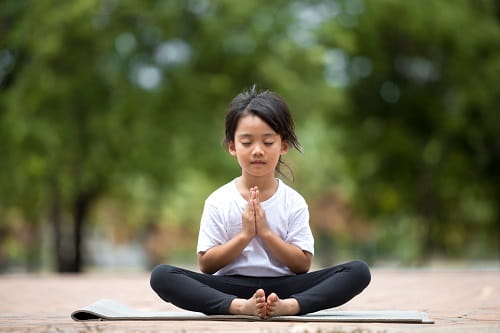The practice of Yoga originated in the Indian sub-continent over 5,000 years ago. Yoga itself is not a religion and over centuries it evolved from a spiritual practice to one of exercise, meditation, and positive thinking. In the late 1800s yoga was introduced to the western world as a practice for mental and physical rejuvenation.
Benefits of yoga are well studied in adults but it is not widely introduced to children. In young children of preschool age (3 – 6 years), a yoga and mindfulness practice can help develop motor skills, support emotional wellbeing and self-esteem, manage anxiety, and improve sleep. The Montessori Early Childhood classroom is a good environment to introduce habits of self-care. Those who have read or know the teachings and philosophy of Maria Montessori will find that mindfulness and awareness are built in the teaching methods and lessons.
“The first essential for the child’s development is concentration. The child who concentrates is immensely happy.”
– Maria Montessori
As a certified yoga teacher, founder, and co-owner of The Foundations Montessori School, I have had the opportunity to incorporate a practice of physical movement, stretching, and breathing as a morning routine for children of age 3 – 6 years. Our teachers also assisted with leading the group practice which we continued for over 4 years.
However, we had to restrict group sizes due to the pandemic and had to give up this morning practice. As we slowly entered the second year of the pandemic, we realized the importance of having at least one fitness-based activity in all our Early Childhood classrooms. Children who returned to school after a few months or more of being at home had spent more time with iPads or smartphones, less time in outdoor play, and had less peer interaction. All of these have taken a toll on the mental health of many young children.
Movement and physical activity is more important now than ever before. At our school, we have introduced yoga and mindfulness in our classrooms where it is accessible for children to practice at their free will.
What is Yoga to a Child?
The literal meaning of the word Yoga is to unite or connect the mind and body. It is important to create interest and simplicity when presenting a new concept to young children. The beauty of yoga is that it can be practiced anywhere with just a mat. A simple yoga and mindfulness practice for children can include:
- Learning to sit still
- Child friendly poses such as mountain pose, downward dog, butterfly, warrior pose, tree pose
- Stretching
- Breathing
- Counting breath (mindfulness)
- Relaxation (lying down)
Yoga in a Montessori environment
The calm, peaceful surrounding, carefully laid out material on wooden shelves, soft voices, and quiet movement of children in a Montessori classroom make an environment that is already primed for a yoga practice. The teacher demonstrates lessons with slow intentional step by step movements using minimal words. The way a child works with Montessori materials on a rug is comparable to a mindfulness practice. Mindfulness develops from the focus and concentration developed while working with the didactic materials created by Montessori. In a Montessori environment, teachers believe in guiding and nurturing children not only to build on the basic concepts of education such as reading, writing, and math, but also guide them to achieve emotional freedom and the ability to make good choices.
How to Prepare a Yoga Lesson for a Montessori Classroom
For our classroom material, one of our teachers suggested we create a lesson with a few cards showing simple yoga poses on a shelf with a mat tucked away in a corner. The lesson is kept simple and includes a small wooden tray to hold 4 – 5 laminated cards with pictures of a child in basic yoga poses, a small box of wet wipes, an empty small container to discard used wipes, and a yoga mat rolled up to stand in a corner close by.
The teacher introduces and demonstrates the simple lesson:
- Discuss when it is time for yoga. We choose this as an opportunity to talk about feelings, emotions, and when there is a need to calm down.
- Bring the mat to a quiet space and unroll it.
- Carry the tray with the yoga lesson.
- Clean the mat with a wipe.
- Lay out the cards and practice each pose slowly with intention.
- We count our breath and hold each pose for 3 breaths.
- When done with each pose on the cards, lie down on the mat for a few minutes.
- Clean up the mat with a wipe and roll it up neatly to put it away and restore the work.
Once the teacher has introduced the lesson, the children are eager to practice. With teacher guided lessons and picture cards, children learn the poses and become well-versed with the practice of sitting still and breathing. We have since seen children in their classrooms choose their own time and space to roll out the yoga mat and practice poses, breathe, or simply lie down to calm down.
How to Teach Mindfulness to Young Children
Our lessons include simple breathing techniques such as “humming like the bees.” Instructions are simple:
The opinions expressed in Montessori Life are those of the authors and do not necessarily represent the position of AMS.


